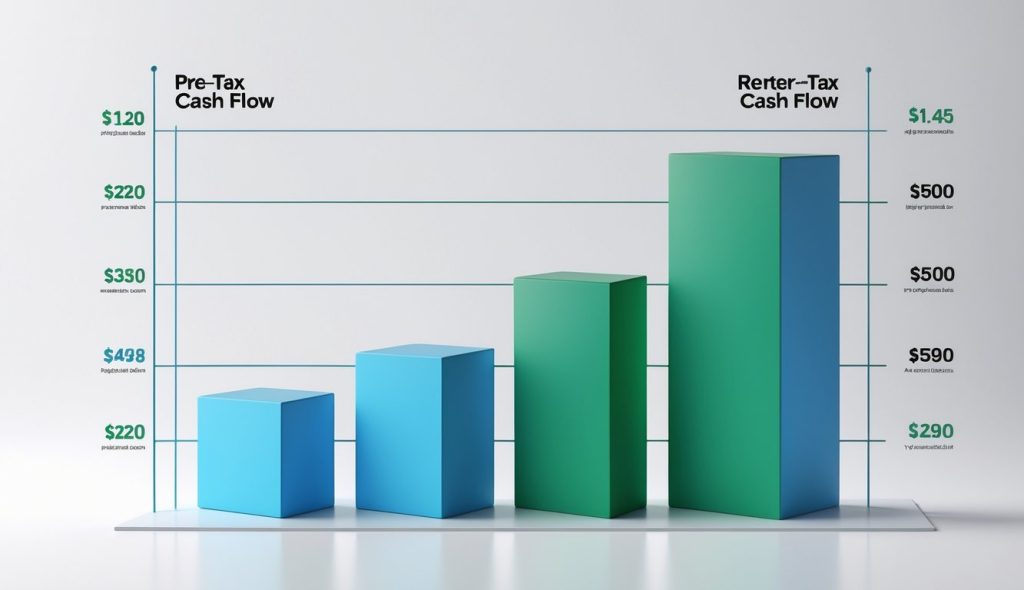How to Maximize Pre-Tax Cash Flow in Real Estate Investing

Understanding your property’s pre-tax cash flow can make the difference between a profitable investment and a financial pitfall. Pre-tax cash flow is the amount of money your investment generates after accounting for operating expenses and debt service, but before any taxes are paid. Knowing how to calculate and analyze this metric gives you a more accurate picture of your property’s real performance and helps you compare different opportunities apples to apples.
Maximizing pre-tax cash flow isn’t just about finding high-rent properties; it also involves controlling expenses, optimizing rental income, and making smart financing decisions. When you know how to evaluate pre-tax cash flow, you’re better equipped to make decisions that support your long-term financial goals and reduce risk. This article will guide you through the ins and outs of pre-tax cash flow, offering practical steps for real estate investors at any experience level.
Key Takeaways
- Pre-tax cash flow measures income after expenses and debt, before taxes.
- Accurate calculation helps you compare and improve rental property performance.
- Simple strategies can help you optimize your real estate investment returns.
Understanding Pre-Tax Cash Flow in Real Estate
Pre-tax cash flow reflects how much money you pocket from a property after covering operating costs and debt payments, but before accounting for income taxes. Knowing how to calculate and interpret this metric helps you make clear, data-driven investment decisions.
Definition and Key Concepts
Pre-tax cash flow, often called before-tax cash flow (BTCF), measures the cash remaining after deducting all operating expenses and debt service from the income generated by a property. It does not include income taxes, which are handled separately at the individual or entity level.
This cash flow figure is critical in real estate because it shows the amount of liquidity produced by the property. You calculate it as:
Pre-Tax Cash Flow = Net Operating Income (NOI) – Debt Service
Net operating income (NOI) includes all rental income and other property revenue minus operating expenses (but before mortgage payments and taxes).
BTCF allows you to evaluate a property’s performance regardless of your personal or business tax situation. This helps you compare different properties on an equal footing. For a more detailed explanation of the calculation, CommLoan offers a breakdown of before-tax cash flow.
How Pre-Tax Cash Flow Differs from NOI
Net operating income (NOI) focuses on the money a property generates after operational expenses but before factoring in any financing or tax costs. Pre-tax cash flow goes a step further by also subtracting debt service (mortgage principal and interest).
These differences mean:
- NOI tells you about the project’s operational efficiency.
- Pre-tax cash flow highlights how much cash is actually available to you after loan payments.
For example, if two properties have the same NOI but different debt levels, their pre-tax cash flows will differ significantly. This distinction is vital for investors who leverage financing in real estate deals. You can see the difference laid out in more detail at Taxfyle’s explanation of NOI vs. cash flow.
Importance in Property Investment
Understanding pre-tax cash flow helps you assess a property’s actual ability to generate cash. Unlike net income or NOI, which exclude financing costs, pre-tax cash flow accounts for how much money is left after you pay your lender each month.
This metric is commonly used to:
- Evaluate whether a property can support its debt obligations.
- Compare potential investments when considering financing options.
- Assess risk by seeing how much of the cash flow remains after required payments.
Investors rely on this metric to measure the stability and predictability of a property’s returns. Positive pre-tax cash flow typically means your investment is generating surplus income before taxes.
Role in Real Estate Investment Strategies
Pre-tax cash flow shapes your real estate investment strategy by influencing decisions about leverage, acquisition, and property management. Strong pre-tax cash flow offers greater flexibility, allowing for reinvestment or cushioning against market downturns.
Some investors use this metric to screen properties, favoring those with stable, strong cash flows that fit their risk tolerance. Others may pursue value-add opportunities, aiming to increase pre-tax cash flow through property improvements, new management, or optimizing expenses.
Focusing on pre-tax cash flow also supports long-term portfolio growth and risk management, as properties that consistently generate robust cash flow can help sustain your investment strategy across various market cycles. For a practical overview of its use in strategies, Wall Street Prep discusses pre-tax cash flow in real estate.
Analyzing and Maximizing Pre-Tax Cash Flow
Maximizing pre-tax cash flow requires a thorough understanding of rental income, operating expenses, and your financing strategy. Precision in tracking these financial elements is critical to evaluating investment performance and achieving long-term profitability.
Calculating Pre-Tax Cash Flow
Pre-tax cash flow, sometimes called before-tax cash flow, is the amount of money left after collecting rent and paying for expenses and debt service, but before factoring in income taxes. The formula is:
Pre-Tax Cash Flow = Net Operating Income (NOI) – Debt Service
To break this down further:
- Net Operating Income is total rental income minus operating expenses like maintenance, property management, property taxes, insurance, and utilities.
- Debt Service is your annual mortgage payment, including both principal and interest.
For an accurate cash flow analysis, use actual numbers for rent, expected vacancy rate, and each operating cost to ensure your projections closely reflect the property’s reality. Consider using detailed calculators or templates to streamline this process.
Key Drivers and Variables
Key drivers of pre-tax cash flow include rental rates, vacancy rate, operating expenses, and loan terms. You must also watch capital expenditures, which can fluctuate from year to year depending on property maintenance and improvements.
If rental income rises or vacancy decreases, your cash flows will generally improve. Conversely, increasing property taxes, rising insurance costs, or spikes in utility expenses will erode profitability. The type of rental property you own—such as single-family, multifamily, or commercial—also affects both income and expenses.
Factors like property management fees, market value changes, and adherence to the 1% rule can have a direct impact on cash flow as well. Monitoring these variables gives you more control over your investment’s returns and risk profile.
Impact of Operating Expenses and Debt Service
Operating expenses are recurring costs necessary to run the property, such as repairs, property management, insurance, taxes, and utilities. Keeping these under control is crucial for healthy cash flows; inefficient oversight can lead to steadily declining returns.
Debt service is often your largest single expense. The size of your mortgage, interest rate, and amortization period shape how much cash remains each month. If the property’s gross potential income (GPI) fails to sufficiently cover both operating expenses and debt service, you’ll face negative cash flow.
Detailed tracking of both fixed expenses (such as mortgage payments) and variable costs (like unexpected repairs) is key. Small improvements in expense management can yield noticeable gains in pre-tax cash flow and even impact important metrics like cash-on-cash return and return on investment.
Improving Profitability and Cash Flows
To increase profitability, first focus on raising rental income by setting competitive rental rates and reducing vacancy rates through effective tenant screening and retention. Implementing regular rent reviews is also important in staying aligned with current market value.
You can boost operating cash flows by controlling or reducing expenses—shop around for insurance, invest in preventative property maintenance, and scrutinize property management fees. Consider energy-efficient upgrades to lower utility costs.
Evaluate refinancing options or more favorable loan products to reduce debt service payments. Before committing to capital expenditures, conduct a financial analysis to ensure ROI justifies the outlay. Consistent review of your rental property’s financial performance, including key metrics like net present value (NPV) and internal rate of return (IRR), helps guide informed buy and sell decisions while keeping your investment goals in focus.
Frequently Asked Questions
Pre-tax cash flow is a key metric that helps you understand the financial performance of a real estate investment before tax obligations are considered. Grasping this concept enables you to evaluate property profitability, compare investment opportunities, and make more informed financial decisions.
How is pre-tax cash flow calculated in real estate investments?
You calculate pre-tax cash flow by subtracting both operating expenses and debt service from the total income generated by the property. This shows you the cash remaining before accounting for any taxes. The calculation is straightforward and can help you quickly assess the viability of an investment.
What is an example of pre-tax cash flow from a real estate investment?
Suppose your rental property generates $30,000 a year in income. If operating expenses are $10,000 and annual mortgage payments total $12,000, your pre-tax cash flow would be $8,000. This gives you a clear view of annual cash profits before tax responsibilities are factored in.
What is the formula used to determine before-tax cash flow?
The formula for pre-tax cash flow is:
Pre-Tax Cash Flow = Net Operating Income (NOI) – Debt Service
Net Operating Income is total rental income minus operating expenses. Debt service includes all loan payments made during the year. For more on the formula and related calculations, review this before-tax cash flow guide.
How does pre-tax cash flow differ from after-tax cash flow in property investments?
Pre-tax cash flow does not include the impact of income taxes, while after-tax cash flow is the amount remaining after taxes are paid. The distinction is important because tax obligations can vary depending on your situation and the type of property. This can affect your true profit from the investment.
What does the ‘2% rule’ in real estate refer to?
The ‘2% rule’ is a guideline suggesting that a good investment property should rent for at least 2% of its purchase price each month. For example, if a property costs $100,000, you should expect rent of at least $2,000 per month. This rule is used to help you quickly screen and compare potential rental properties.
How are return on investment (ROI) and cash on cash return (CoC) distinct in real estate analysis?
Return on investment (ROI) measures your total profit as a percentage of the total money invested, including financing, improvements, and other expenses. Cash on cash return (CoC), however, focuses only on the cash income you received relative to the actual cash you invested. Each metric provides a different perspective on your investment’s performance. For further details, see a breakdown of common real estate cash flow and ROI questions.
Ever wish you could analyze properties like the pros?
Save time and make smarter investment decisions with the most powerful real estate analysis software on the market.
Enter the code BESTDEAL at check out and receive a 20% Off Discount!

Master the art of real estate investing with The Real Estate Property Management Guide: Premium Edition – your comprehensive roadmap to successful property management.
Whether you’re a novice investor or seasoned professional, this guide covers everything from selecting the right investment properties to tenant management and property marketing.
The author, Jeff Rohde writing as Jeffrey Roark, is a professional with over 25 years of real estate experience. This Premium Edition includes the valuable bonus book Investment Real Estate Analysis: A Case Study to help you identify hidden opportunities and evaluate properties like a professional.
Learn practical, actionable strategies for both residential and commercial properties, from single-family homes to office buildings and shopping centers.
Don’t just buy property – learn how to manage it successfully and maximize your investment potential.
Grab your copy now from your favorite bookseller:
- Amazon (Basic Edition, does not include Investment Real Estate Analysis: A Case Study)
- Books2Read for Apple, Barnes & Noble, Kobo, Scribed, and 8 more sellers with both eBook and paperback options available ((Premium Edition, includes Investment Real Estate Analysis: A Case Study)
- Payhip as a downloadable PDF (Premium Edition)
Ready to take your business to the next level?
- Subscribe to our newsletter
- Visit the learning center
- Learn more about our consulting services